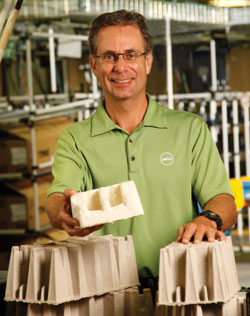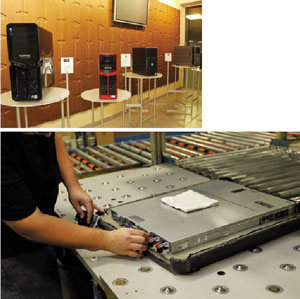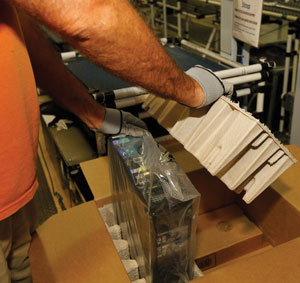Dell’s Campbell: the Whole Package
By Kate Bachman | September 27, 2012
Category:
Take a Byte. Oliver Campbell, Dell director of packaging procurement, serves up some cushioning packaging derived naturally that is recycled, recyclable, biodegradable, and one that is even somewhat edible. The farmer-turned-engineer drew on his agricultural background to develop out-of-the-box sustainable packaging.
Oliver Campbell is a Volt®-driving, composter-using, mushroom-growing, bamboo harvesting, sustainable packaging tour de force. He doesn’t just talk about sustainability, he drives it, he recycles it, he composts it, he grows it, he lives it.
If triathlete Campbell were to ride with fellow Austinite Lance Armstrong, he’d be as likely to scour the countryside for his next vegetative packaging material as enjoy the view.
Campbell, who is Dell’s director of packaging procurement, is in the process of greening the packaging the tech giant uses to protect its servers, desktop computers, laptops, and notebooks during shipping (see Figure 1). The company says this is indicative of its entire larger life cycle approach to sustainability. “We design products and packaging with the planet in mind, considering their environmental impact at each stage of their existence,” Campbell professes.
The Whole Problem
“For years customers received their products in unnecessarily large boxes filled with Styrofoam® and made with material that is not exactly easy to recycle,” Campbell wrote in a recent blog posting. “At Dell, we’re developing new possibilities in packaging by using innovative techniques that we believe are truly sustainable. Why? Quite simply, our customers have told us that this is what they want.”
And tell Dell they did. Customers were very vocal about what they didn’t like about the packaging, especially in social networking avenues. Some bloggers had sharp opinions about the sustainability of Dell packaging.”What we came to realize is that customers really have strong feelings about the packaging. They wanted us to care as much about the environment as they do.
“And we are very tied into our customers. That’s part of the Dell DNA—that direct relationship,” Campbell continued. “Our customers asked, ‘Can you make the packaging smaller? Use more recycled or sustainable content? Make the material easily recyclable so that I can dispose of it in a sustainable manner?’
“Our RFQs for green packaging have tripled in the last three years,” Campbell added.
Shrinking the Box, Into the Box, Onto the Curb
Campbell and his team got to work setting ambitious goals for what they call their 3Cs—cube, content, curb—reducing the size of all the packaging by more than 12 percent; increasing the amount of recycled and renewable content by up to 40 percent; and changing the packaging so as much as 75 percent of it is recyclable curbside.
These efforts have eliminated more than 20 million pounds of packaging material, Campbell reported. Not only was this good for the environment and customers, but it was also good for business, saving more than $18 million as a result, he said.
How the team achieved those goals centered largely on the materials they chose, particularly the cushioning packaging that is critical to protecting the computers’ sensitive and vulnerable tiny components. “We’re substantially decreasing the use of polystyrenes and polyethylenes,” Campbell said.
Packaging in a Material World

Figure 1
A $60 billion, 100,000-employee tech corporation, Dell has plants and supplier plants not only at its headquarters in Austin, Texas, shown here, but also in Mexico, Malaysia, India, China, Brazil, and Poland—about a dozen in all. Because servers and many desktops are very complicated and sophisticated, highly skilled technicians build an entire unit in a cell manufacturing environment to help ensure quality.
Molded Paper Fiber. One of the cushioning materials Dell turned to is molded fiber, which is recycled newspaper and water (see “Out-of-the-box sustainable packaging options for manufacturers, p. 24). It satisfies the recycled content, recyclable-at-curbside goal, and is biodegradable. Dell uses molded fiber cushioning material to protect many of its desktop computers (see Figure 2).
Customers have responded well, Campbell said. One customer in the entertainment industry wrote, “Hey, we’re really glad that you’re eliminating Styrofoam, and that your cushioning material is made out of recycled newspaper. It makes it easy to recycle and less costly to dispose of, and that makes us feel good.”
Recycled HDPE. Other notebooks and desktop units are shipped with cushioning made of high-density polyethylene (HDPE) sourced from recycled milk jugs and detergent bottles. “So that’s a green solution too. People don’t quite always recognize it as such, but we did a calculation earlier this year, and if you took all the recycled HDPE that we use, the equivalent amount of half-gallon milk jugs would stretch all the way across the United States.”
Bamboo. The idea for use of a third sustainable material Campbell and his team developed for cushioning was derived from the sustainability concept of local sourcing, as well as using recyclable and renewable content.
Bamboo, a rapidly renewable material, grows in China near some of the company’s plants and suppliers. Sourcing materials locally in the region of manufacture is considered more sustainable than shipping and trucking them across hundreds or thousands of miles to the site of manufacture, with the accompanying transportation emissions—often countering the positive effects achieved by using sustainable materials.
“We were familiar with bamboo and some of its mechanical properties. We knew it had a lot of similarities with molded paper pulp. The bamboo fiber is a little stronger, with tensile strength equivalent to that of steel,” he said.
Bamboo is used widely in construction, in rice steamers, and many applications, Campbell relayed. “Its very ancient material. And for the Chinese in particular, bamboo represents integrity.
“So we thought it was perfect for protecting some of our high-tech products, but nobody had really used it in packaging on a large scale,” Campbell said.
The team worked with one of its suppliers on developing the bamboo cushion packaging for a year, and then launched it in 2009. “It’s proven to be very, very successful,” he said. “We now ship approximately 70 percent of our notebooks in bamboo.”
Campbell pointed out that Dell has been careful to perform due diligence in ensuring that the harvesting of the bamboo is done sustainably, and that the packaging is, in fact, recyclable and compostable.
“We’ve walked the supply chain in Jiangxi Province in China several times, inspecting their harvesting practices. The harvesting of the bamboo trees is done via selective cutting, not clear cutting, and bamboo naturally regenerates,” he said, adding that the bamboo Dell uses is FSC (Forest Stewardship Council)-certified.
The bamboo is mechanically pulped, which which aids its compostability, Campbell explained. The process has passed ASTM testing to ensure that it supports plant life. “When they do the test, the final step is to plant seeds to make sure something can grow in it. We passed the test and we got some healthy lima beans out of it.”
Dell also put the bamboo packaging through extensive recyclability testing. Georgia-Pacific conducted numerous paper tests of blends of various percentages, with good results, Campbell said. He ran tests with GP Harmon Recycling, paper brokers, and municipal recycling facilities to make sure they would accept it for recycling. “Because if they won’t accept it, is it really recyclable?
“So, an extensive amount of work went into being able to say yes, it’s compostable and recyclable,” Campbell said.
Then Campbell ran the material through one final test. “Everything we say is compostable—from bamboo to mushroom—goes into my composter at home. If it doesn’t pass that test, we’re not going to make a claim,” he said.
Borrowing From Agriculture: Mushroom Packaging

Figure 2
The importance of cushioning packaging has increased as the size of computers and servers—and their componentry—has decreased. Here, an employee positions a desktop unit into molded paper fiber cushions in Dell’s Austin, Texas, manufacturing plant.
A recent material Campbell and his team have been developing for use as cushioning is a little more left field—as in, the back 40.
Mushroom Packaging. The genesis for the newest cushioning material originated from Campbell’s agricultural background. He grew up in a farming community, working on dairy farms and his family’s blueberry farm in the Finger Lakes region of upstate New York. He and his wife also grew and harvested shiitake mushrooms in Austin to sell at a local farmers’ market.
“As we were looking at materials, I wondered if we could steal an idea from agriculture.”
The bamboo packaging had worked well to protect smaller products, such as notebooks, but Campbell felt that it wasn’t as suitable for larger products, such as some of Dell’s servers. “We needed something that had more structural rigidity in terms of compression and other engineering characteristics. Plus, while bamboo is classified as rapidly renewable, could we use something that was ultra-rapidly renewable? And we started thinking about using agricultural waste.”
Campbell and his team met a start-up company called Ecovative at a Greener Gadget conference that had heard about Dell’s use of bamboo cushioning. One of the company founders grew up on a maple syrup farm in Vermont.
“So we had two farming backgrounds. When they started talking about mushroom mycelium—I knew about that from having grown mushrooms—and I thought, yeah, I get that.”
So Campbell’s team partnered with Ecovative to develop the technology for commercialization. “People ask why a big, $60 billion, giant tech company is working with a company that’s really just coming out of the garage, but Michael Dell started Dell in his dorm room. So if you go back to our beginnings, we really aren’t that much different.
“They had the basic biological technology and we brought the packaging engineering,” Campbell said. The technology uses the sugars and carbohydrates in agricultural waste plant material as the energy source for the mushroom mycelium to propagate and grow the cushion. “So we’re not reliant on petroleum, natural gas, or nuclear power. So that’s kind of neat,” Campbell said.
“And now it’s clear why this technology has been heavily funded by the U.S. EPA, Dept. of Energy, the National Science Foundation, and all these really smart government agencies to help develop it.
“For the agricultural waste, we’re using cotton hulls sourced out of west Texas,” Campbell said. “This is a material that cotton gins pay to have taken away.”
Pilot Program. Dell concluded its mushroom packaging pilot program last month with an unnamed FORTUNE 50® company—a large-volume Dell customer with a progressive sustainability program. It was a yearlong development effort.
The team selected Dell’s R710 server to use in a multipack configuration to test the mushroom packaging. “There’s about $25,000 worth of servers in there. So we had a lot of belief in our work,” Campbell said.
There were some jaw-dropping moments. “The mushroom packaging actually performed better in the drop tests than our foams did. We were very surprised by that.”
Making a material change has effects beyond the material; it involves changing suppliers and supply chains as well, Campbell said. These often are accompanied by a lot of questions. What is it? How do you handle it? How do you communicate how to handle it?
He looked at the entire supply chain, not just at Dell’s facilities, but also what happened when distributors received it, how their facilities teams handled it, and how the composter handled it.
“It went very well, and we’re looking to expand [the mushroom packaging program],” Campbell said. “What’s happening with our biological packaging is that it is evolving. We are already looking at the second generation, which is far more advanced. And we think there are several more beyond that. So we’re excited to see where this technology will go.”
Changing the Face of Traditional Packaging
When Campbell’s teenaged daughter challenged him to join her in participating in a triathlon five years ago, his competitive spirit arose and he couldn’t resist the challenge. He had not done one before, but he had run track at Cornell University, so he thought he’d draw on that and figure out the rest. He’s been a triathlete ever since, and in August, he competed in the prestigious U.S. Triathlon Sprint National Championship.
It was that same competitive spirit, engineering ingenuity, commitment to excellence, and environmental inclination that propelled Campbell to accept the challenges inherent in heading up the initiative to green Dell’s packaging.
The fact that he had not been entrenched in the packaging industry freed him up to take a fresh approach to the challenge. “When we first started on this journey, a lot of people in the [packaging] industry told us it couldn’t be done.
“I asked, ‘Why not?’ Packaging is a very mature industry, and the technology has been stable for a number of decades. It provided great solutions, but the world is changing. And so I came into this, I guess, somewhat naively, and I think that turned out to be one of my greatest strengths,” Campbell said.
He said the resolution was in finding the right partners who would be willing to take on the hills in the road, and fortunately, he found them. “And that’s how we’ve been able to innovate with many of these new materials.”
Thinking Like a Champion
“When we started out, I told my team that my goal for them is to be the world’s best packagers. It’s about a way of thinking and an attitude. I wanted the team to start taking some of the risks that a champion takes—not dumb ones, but smart ones.
“That’s really important, because we set some pretty steep goals—reduce our packaging by 10 percent, increase recycled content by 40 percent, and increase the amount of packaging that can be recycled curbside by 70 percent. When you’re a $60 billion global company with 100,000 employees, that’s a pretty big mountain to climb.
“And I guess it was that sense of competition that attracted me to competing in triathlons … that sense of excellence that we focused on. We did the analysis. We did our homework, and we felt we could do it, and we accomplished every goal we set.
“I’m very proud of my team,” he added.
Campbell said that although he’s happy with his recent showing in the nationals, his daughter still finishes the competitions faster than he does.
“I still haven’t beaten her yet. Her wave usually starts behind mine, and somewhere on the bike leg of the race, I’ll hear, ‘Hi, Daddy,’ as she rides by.
Dell Inc., 1 Dell Way, Round Rock, TX 78664, 800-289-3355, Twitter@dell, www.dell.com

Side by side, we move metal fabrication forward.
FMA unites thousands of metal fabrication and manufacturing professionals around a common purpose: to shape the future of our industry, and in turn shape the world.
Learn More About FMA

.jpg)
